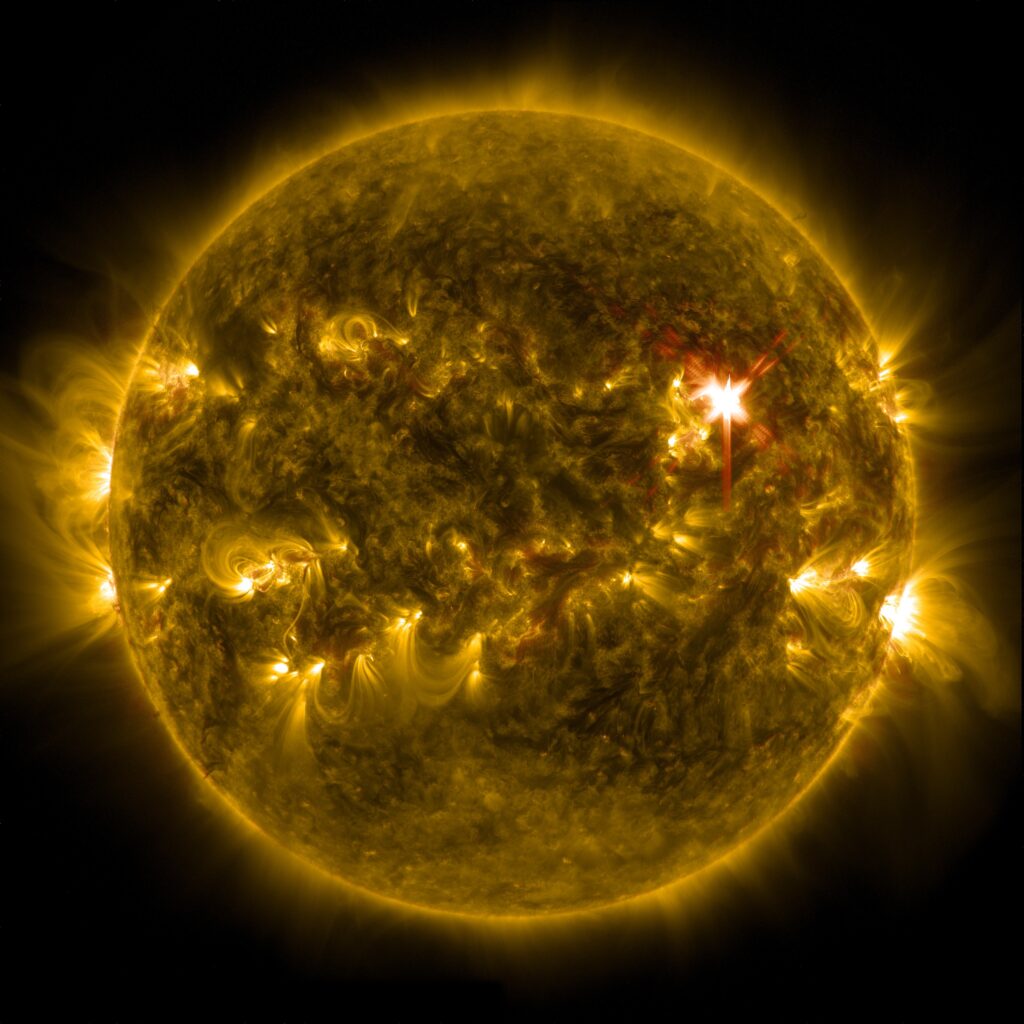Table of Contents
Aditya L1: Intro
In the realm of space exploration, Aditya-L1 emerges as a pioneering Indian mission poised to unravel the mysteries of the Sun. This space borne endeavor marks a significant leap in our understanding of our closest stellar neighbor. Positioned within a halo orbit encircling the Lagrange point 1 (L1) of the Sun-Earth system, Aditya L1 is set to revolutionize our comprehension of solar dynamics and space weather phenomena.

Unlocking Uninterrupted Solar Insights
By nestling itself approximately 1.5 million km away from Earth, within the embrace of the L1 Lagrange point, Aditya L1 gains an unprecedented advantage. Unlike its terrestrial counterparts, it enjoys an unobstructed and ceaseless view of the Sun. Shielded from the hindrance of occultations and eclipses, this strategic positioning facilitates continuous observation of solar activities in real-time. This vantage point promises a profound understanding of the Sun’s impact on space weather. Learn about Moon Mission Luna-25
Major Science Objectives
- Understanding the Coronal Heating and Solar Wind Acceleration.
- Understanding initiation of Coronal Mass Ejection (CME), flares and near-earth space weather.
- To understand coupling and dynamics of the solar atmosphere.
- To understand solar wind distribution and temperature anisotropy.

Uniqueness Of The Mission
- First time spatially resolved solar disk in the near UV band.
- CME dynamics close to the solar disk (~ from 1.05 solar radius) and thereby providing information in the acceleration regime of CME which is not observed consistently.
- On-board intelligence to detect CMEs and solar flares for optimised observations and data volume.
- Directional and energy anisotropy of solar wind using multi-direction observations.
Why Study The Sun?
Various spacecraft and communication systems are prone to such disturbances and therefore an early warning of such events is important for taking corrective measures beforehand. In addition to these, if an astronaut is directly exposed to such explosive phenomena, he/she would be in danger. The various thermal and magnetic phenomena on the sun are of extreme nature.
Thus, the sun also provides a good natural laboratory to understand those phenomena which cannot be directly studied in the lab. The sun constantly influences the Earth with radiation, heat and constant flow of particles and magnetic fields. The constant flow of particles from the sun is known as solar wind and are mostly composed of high energy protons. The solar wind fills nearly all the space of the known solar system. Along with the solar wind, the solar magnetic field also fill the solar system.
The solar wind along with other explosive/ eruptive solar events like Coronal Mass Ejection (CME) affects the nature of space. During such events, the nature of magnetic field and charge particle environment near to the planet change. In case of the Earth, the interaction of Earth magnetic field with the field carried by CME can trigger a magnetic disturbance near the Earth. Such events can affect the functioning of space assets.
The Payload Odyssey
Central to the Aditya L1 mission are its seven payloads, each meticulously designed to probe distinct facets of the Sun’s composition and behavior. The spacecraft is equipped with cutting-edge electromagnetic, particle, and magnetic field detectors. These technological marvels empower Aditya L1 to scrutinize the photosphere, chromosphere, and the enigmatic corona – the Sun’s outermost layer.

Unraveling Solar Mysteries
Four of these payloads are strategically oriented to directly engage with the Sun, capturing its essence and energy. Meanwhile, the remaining three payloads embark on in-situ studies of particles and fields at the Lagrange point L1. This comprehensive approach sets the stage for groundbreaking revelations about the propagatory influence of solar dynamics across the interplanetary expanse.
Decoding the Aditya L1 Payloads
The suite of payloads aboard Aditya L1 promises to furnish invaluable insights into perplexing solar phenomena. It is poised to illuminate the enigma of coronal heating, unravel the intricacies of coronal mass ejections, and dissect pre-flare and flare activities. Moreover, the spacecraft’s capabilities extend to comprehending the dynamics of space weather – a field of paramount significance in safeguarding our technological infrastructure.
Scientific Objectives at a Glance
The Aditya L1 mission hinges on several critical scientific objectives, including:
- Chromosphere and Corona Dynamics: The mission aims to decipher the intricate dance of the solar upper atmosphere, shedding light on the dynamics of the chromosphere and corona.
- Unveiling Coronal Mysteries: By scrutinizing coronal heating and the behavior of partially ionized plasma, Aditya L1 strives to demystify the genesis of coronal mass ejections and solar flares.
- In-situ Particle Exploration: The spacecraft ventures into the realm of particles and plasma, furnishing invaluable data for studying solar particle dynamics.
- Unraveling Coronary Heating: The physics behind solar corona and its heating mechanisms come into focus, promising to resolve a long-standing puzzle.
- Probing Plasma Diagnostics: Aditya L1 seeks to decode the secrets of coronal loops’ plasma, unraveling crucial parameters like temperature, velocity, and density.
- Cracking the CME Code: The mission endeavors to trace the development, dynamics, and origin of Coronal Mass Ejections (CMEs).
- Journey Through Solar Eruption: By tracing the sequential processes across various layers – chromosphere, base, and extended corona – Aditya L1 aims to elucidate solar eruptive events’ genesis.
- Mapping Magnetic Fields: The spacecraft turns its attention to magnetic field topology and measurements within the solar corona, enhancing our understanding of this intricate domain.
- Unveiling Space Weather Drivers: Delving into the origin, composition, and dynamics of the solar wind, Aditya L1 aims to discern the driving forces behind space weather phenomena.
Final Thoughts
In the grand tapestry of cosmic exploration, Aditya L1 emerges as a shining thread, poised to weave together a comprehensive understanding of our Sun’s behavior and its cascading effects on the interplanetary realm. With its array of payloads and ambitious scientific objectives, this mission promises to reshape our comprehension of solar dynamics and, by extension, fortify our preparedness against the vagaries of space weather. As Aditya L1 embarks on its celestial odyssey, the potential for groundbreaking discoveries beckons – a testament to human ingenuity and our unyielding quest for knowledge.

